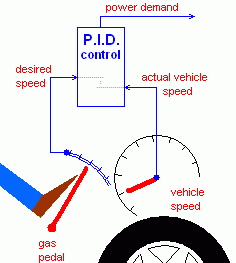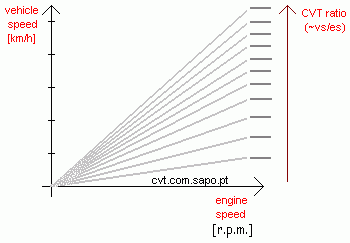
CVT- Continuously Variable Transmission
(a personal approach*)
The CVT makes possible to freely match any engine speedto
any vehicle speed.
This is advantageous because the engine could operate permanently in it'soptimum
engine speeds (and
throttlepositions).
Therefore, it could maximize power output relative to fuel consumption
(or reduce harmful exhaust emissions).
It is needed to regulate CVT ratio
and throttle position, while ensuring maximum
efficiency.
Therefore, it reads three variables: gas pedal
position, engine speed and
vehiclespeed (which depends on the road slope
andexternal loads).

In order to minimize fuel consumption, the engine must operatealong the optimum efficiencycurve in the engine performance map:

With the previous experimental information we can establish the optimum relationshipbetween the throttle position and the enginespeed:

It will express the driver's desired vehicle speed. A greater difference to the actual vehicle speed will request a greater acceleration, thus greater powerdemand. A P.I.D. control will calculate this powerdemand:

It will be used to control the engine, indirectly. Firstof all, the engine must be tested experimentally to obtain it's power curve, whileusing optimum throttle positions. This diagram willbe used to convert any value of power demand intothe corresponding required engine speed:

The instantaneous vehicle speed is measured. Andconsidering the required engine speed the controlwill calculate the necessary CVT ratio (~vs/res).

Thus:
The resulting engine speed will generate thegreater (or smaller) power demand,consequently the vehicle speed will increase (ordecrease), as requested by the driver.

* Some remarks:
- This is a first personal approach and doesn't result from any scientific
research;
- This approach may be largely improved / corrected;
- The control's dynamic response wasn't
considered.
- Neutral mode isn't considered in this section,
neither reverse gear;
- Engine breaking is not considered neither sport-mode;
- This web-page is under development, thus constructive
commentsare welcome to improve
this scratch;
- However you may find useful the researchinformation in
the following web links:
DEMONSTRATION OF ENERGY SAVING IN VEHICLES BY INTEGRATING AN INFINITELY VARIABLE TRANSMISSION WITH AN OPTIMIZED PETROL ENGINE, BRITISH TECHNOLOGY GROUP, http://europa.eu.int/comm/energy/library/tr92.pdf
Component Control for The Zero Inertia Powertrain, Technische Universiteit Eindhoven, http://alexandria.tue.nl/extra2/200142094.pdf
Operating Point Optimizer for Integrated Diesel/CVT Powertrain CJ Brace, M Deacon, ND Vaughan, CR Burrows, University of Bath RW Horrocks, Ford Motor Company, http://www.bath.ac.uk/%7Eenscjb/C51704396.pdf
The potential for simulation of driveability of CVT vehicles Volker Wicke1, Chris J. Brace, Nick D. Vaughan University of Bath, http://www.bath.ac.uk/~enscjb/driveability.pdf
Powertrain related reports and publications - 1993 onwards, University of Bath, United Kingdom, http://www.bath.ac.uk/mech-eng/auto/publications.html
Simulation software "ADVISOR", Center for Transportation Technologies and Systems, National Renewable Energy Laboratory (NREL) in Golden, Colorado, http://www.ctts.nrel.gov/analysis/
Jatco, Toroidal CVT Control, Japan, http://www.jatco.co.jp/ENGLISH/PRODUCTS/at_simulation.html
CVT Forum: http://autos.groups.yahoo.com/group/cvtcontinuouslyvariabletransm/
CVT Forum links: http://www.mybookmarks.com/public/cvt
( Remark: this page is not intended forexperts because it is just a personal opinion. )
[created: 12 Jun 2003, updated: 19 Set 2008 ] [ designed by vb.web.pt ]